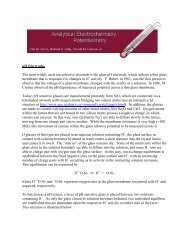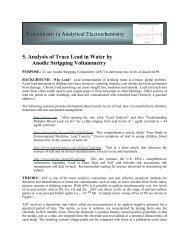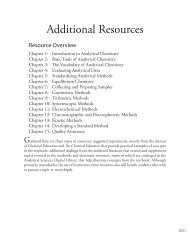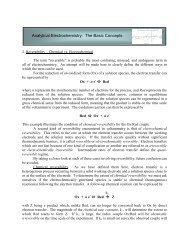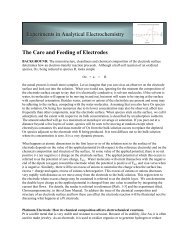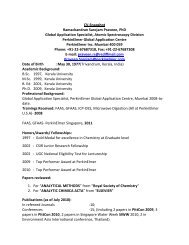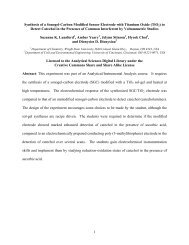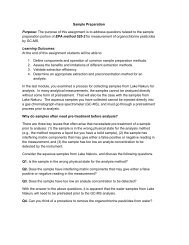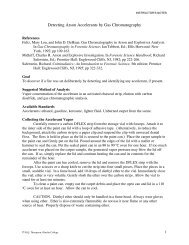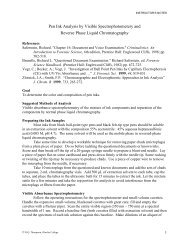Chapter 5 - Analytical Sciences Digital Library
Chapter 5 - Analytical Sciences Digital Library
Chapter 5 - Analytical Sciences Digital Library
You also want an ePaper? Increase the reach of your titles
YUMPU automatically turns print PDFs into web optimized ePapers that Google loves.
172 <strong>Analytical</strong> Chemistry 2.0<br />
5D.1 Linear Regression of Straight Line Calibration Curves<br />
When a calibration curve is a straight-line, we represent it using the following<br />
mathematical equation<br />
y = β + β x<br />
0 1<br />
5.14<br />
where y is the signal, S std , and x is the analyte’s concentration, C std . The<br />
constants b 0 and b 1 are, respectively, the calibration curve’s expected y-intercept<br />
and its expected slope. Because of uncertainty in our measurements,<br />
the best we can do is to estimate values for b 0 and b 1 , which we represent<br />
as b 0 and b 1 . The goal of a linear regression analysis is to determine the<br />
best estimates for b 0 and b 1 . How we do this depends on the uncertainty<br />
in our measurements.<br />
5D.2 Unweighted Linear Regression with Errors in y<br />
The most common approach to completing a linear regression for equation<br />
5.14 makes three assumptions:<br />
(1) that any difference between our experimental data and the calculated<br />
regression line is the result of indeterminate errors affecting y,<br />
(2) that indeterminate errors affecting y are normally distributed, and<br />
(3) that the indeterminate errors in y are independent of the value of x.<br />
Because we assume that the indeterminate errors are the same for all standards,<br />
each standard contributes equally in estimating the slope and the<br />
y-intercept. For this reason the result is considered an unweighted linear<br />
regression.<br />
The second assumption is generally true because of the central limit theorem,<br />
which we considered in <strong>Chapter</strong> 4. The validity of the two remaining<br />
assumptions is less obvious and you should evaluate them before accepting<br />
the results of a linear regression. In particular the first assumption is always<br />
suspect since there will certainly be some indeterminate errors affecting the<br />
values of x. When preparing a calibration curve, however, it is not unusual<br />
for the uncertainty in the signal, S std , to be significantly larger than that for<br />
the concentration of analyte in the standards C std . In such circumstances<br />
the first assumption is usually reasonable.<br />
Ho w a Li n e a r Re g r e s s i o n Wo r k s<br />
To understand the logic of an linear regression consider the example shown<br />
in Figure 5.9, which shows three data points and two possible straight-lines<br />
that might reasonably explain the data. How do we decide how well these<br />
straight-lines fits the data, and how do we determine the best straightline<br />
Let’s focus on the solid line in Figure 5.9. The equation for this line is<br />
ŷ b bx = + 0 1<br />
5.15



